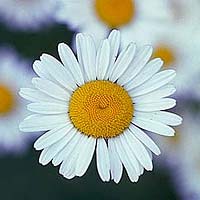 Ultraviolet light may be invisible to humans, but bees can see it and use it to their advantage. Many types of flowers - ox-eye daisies, for example, which to humans look as though they have uniform white petals - appear to bees as ultraviolet lines on a white background.
Ultraviolet light may be invisible to humans, but bees can see it and use it to their advantage. Many types of flowers - ox-eye daisies, for example, which to humans look as though they have uniform white petals - appear to bees as ultraviolet lines on a white background.This pattern is a flower's secret signalling system. Like the runway lights at an airport, it is a direction indicator that guides flying insects to the flower's hidden nectar store, ensuring that the route taken dusts them with pollen. Bees rely on flowers for food and the flowers depend on bees to carry pollen from one flower to the other so that they can reproduce. But bees are not alone in their ablility to see ultraviolet - other insects such as moths also read a flower's signals.
Unlike insects, which do not like cold, wet weather, humming birds fly in most weathers to collect nectar. They are guided by red light, so some plants, such as bananas, advertise their nectar stores with red and orange petals. Only long-billed hummingbirds can reach the nectar, which lies at the bottom of a long flower tube.
Scarlet gilia plants on Fern Mountain in Arizona, USA, change colour to attract a variety of pollinators. In early summer, deep red, a colour that attracts hummingbirds, dominates over white. But when the birds leave, more white than red flowers are produced. White gilias attract hawk moths, which remain all summer. When moths are the only pollinators, the white flowers set twice as much seed as do the red ones.


No comments:
Post a Comment